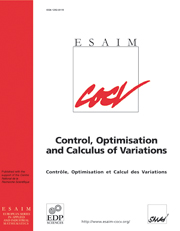Crossref Citations
This article has been cited by the following publications. This list is generated based on data provided by
Crossref.
Han, Ke
Friesz, Terry L.
and
Yao, Tao
2013.
A partial differential equation formulation of Vickrey’s bottleneck model, part II: Numerical analysis and computation.
Transportation Research Part B: Methodological,
Vol. 49,
Issue. ,
p.
75.
Bressan, Alberto
and
Han, Ke
2013.
Existence of optima and equilibria for traffic flow on networks.
Networks & Heterogeneous Media,
Vol. 8,
Issue. 3,
p.
627.
Han, Ke
Friesz, Terry L.
and
Yao, Tao
2013.
Existence of simultaneous route and departure choice dynamic user equilibrium.
Transportation Research Part B: Methodological,
Vol. 53,
Issue. ,
p.
17.
Han, Ke
Friesz, Terry L.
and
Yao, Tao
2013.
A partial differential equation formulation of Vickrey’s bottleneck model, part I: Methodology and theoretical analysis.
Transportation Research Part B: Methodological,
Vol. 49,
Issue. ,
p.
55.
Han, Ke
Friesz, Terry L.
and
Yao, Tao
2014.
A Variational Approach for Continuous Supply Chain Networks.
SIAM Journal on Control and Optimization,
Vol. 52,
Issue. 1,
p.
663.
Cristiani, Emiliano
and
S. Priuli, Fabio
2015.
A destination-preserving model for simulating Wardrop equilibria in traffic flow on networks.
Networks & Heterogeneous Media,
Vol. 10,
Issue. 4,
p.
857.
Bressan, Alberto
and
T. Nguyen, Khai
2015.
Optima and
equilibria for traffic flow on networks
with backward propagating queues.
Networks & Heterogeneous Media,
Vol. 10,
Issue. 4,
p.
717.
Colombo, Rinaldo M.
and
Holden, Helge
2016.
On the Braess Paradox with Nonlinear Dynamics and Control Theory.
Journal of Optimization Theory and Applications,
Vol. 168,
Issue. 1,
p.
216.
Ratliff, Lillian J.
Burden, Samuel A.
and
Sastry, S. Shankar
2016.
On the Characterization of Local Nash Equilibria in Continuous Games.
IEEE Transactions on Automatic Control,
Vol. 61,
Issue. 8,
p.
2301.
Han, Ke
Yao, Tao
Jiang, Chaozhe
and
Friesz, Terry L.
2017.
Lagrangian-based Hydrodynamic Model for Traffic Data Fusion on Freeways.
Networks and Spatial Economics,
Vol. 17,
Issue. 4,
p.
1071.
Li, Yaping
Wen, Decheng
and
Sun, Xiaojing
2018.
Quality supervision game between government and online shopping platforms.
Total Quality Management & Business Excellence,
Vol. 29,
Issue. 9-10,
p.
1246.
Bressan, Alberto
and
Huang, Yucong
2019.
Globally optimal departure rates for several groups of drivers.
Mathematics in Engineering,
Vol. 1,
Issue. 3,
p.
583.
Bressan, Alberto
and
Staicu, Vasile
2019.
On the Competitive Harvesting of Marine Resources.
SIAM Journal on Control and Optimization,
Vol. 57,
Issue. 6,
p.
3961.
Colombo, Rinaldo M.
Holden, Helge
and
Marcellini, Francesca
2020.
On the Microscopic Modeling of Vehicular Traffic on General Networks.
SIAM Journal on Applied Mathematics,
Vol. 80,
Issue. 3,
p.
1377.
Ulbrich, Michael
and
Fritz, Julia
2024.
On generalized Nash equilibrium problems in infinite-dimensional spaces using Nikaido–Isoda type functionals.
Optimization Methods and Software,
p.
1.


